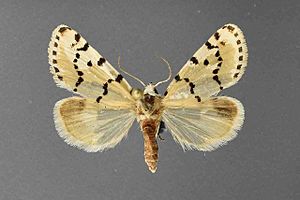Grotella binda facts for kids
Quick facts for kids Grotella binda |
|
|---|---|
 |
|
| Grotella dis | |
| Scientific classification | |
| Kingdom: | |
| Phylum: | |
| Class: | |
| Order: | |
| Family: | |
| Genus: |
Grotella
|
| Species: |
G. binda
|
| Binomial name | |
| Grotella binda Barnes & McDunnough, 1907
|
|
Grotella binda is a type of moth that belongs to the genus Grotella and the family Noctuidae. This moth species lives in North America. It was first found in Arizona.
Contents
What is Grotella binda?
Grotella binda is a small, winged insect. It is part of a large group of insects called Lepidoptera, which includes both moths and butterflies. Moths like Grotella binda are often active at night. They play an important role in their ecosystems, sometimes helping to pollinate plants.
Where Does This Moth Live?
This special moth species is native to North America. Scientists first discovered Grotella binda in the state of Arizona, which is known for its deserts and unique wildlife. Moths usually live in specific habitats where they can find the right plants for their caterpillars to eat.
How Was Grotella binda Discovered?
Grotella binda was officially named and described in 1907. Two important scientists, William Barnes and James Halliday McDunnough, were the first to identify and classify this moth. They were entomologists, which means they were scientists who study insects. Their work helped us learn more about the amazing variety of life on Earth.
The Moth Life Cycle
Like all moths, Grotella binda goes through a fascinating life cycle called metamorphosis. This cycle has four main stages:
- Egg: The life of a moth begins as a tiny egg, often laid on a specific plant.
- Larva (Caterpillar): When the egg hatches, a larva, or caterpillar, emerges. The caterpillar's main job is to eat and grow. It sheds its skin several times as it gets bigger.
- Pupa: After growing enough, the caterpillar forms a pupa. For many moths, this stage is inside a cocoon. During this time, the caterpillar transforms into an adult moth.
- Adult Moth: Finally, the adult moth emerges from the pupa. Its main goal is to find a mate and lay eggs, starting the cycle all over again.

